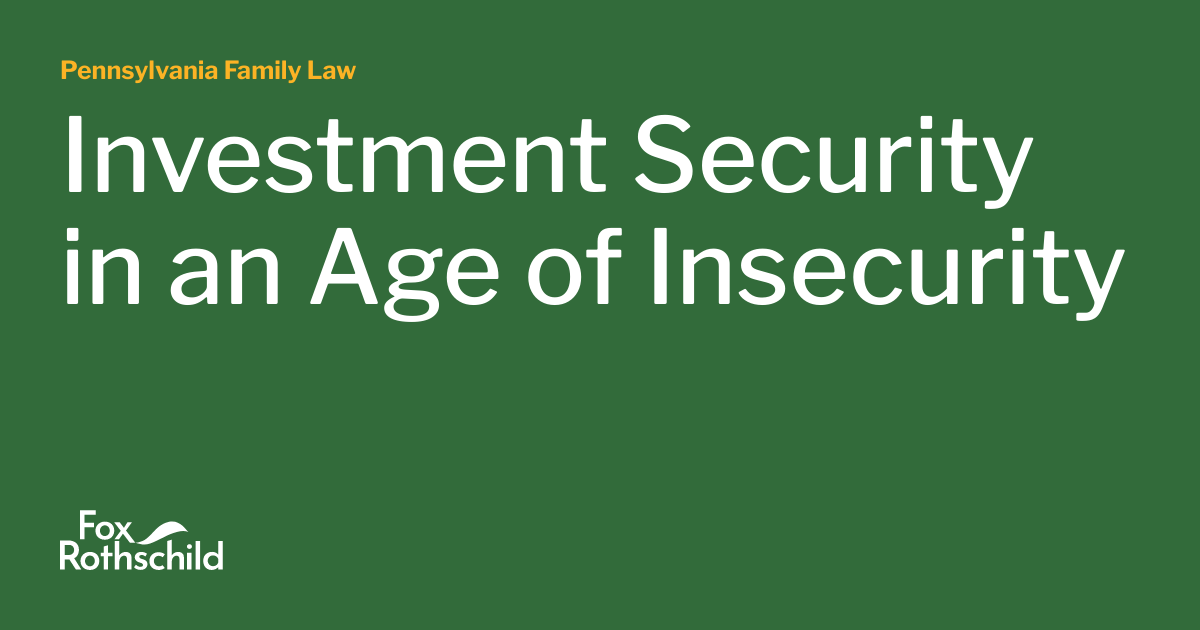Representing clients going through divorce is itself a challenging task because what clients want from that process is often quite varied. Clients from the world of venture capital or real estate are often willing to forego financial security for the next “big deal.” Some have been through some tough times in the real estate world including 1990 and 2008. But they are energized by risk because balled up inside the risk is opportunity. More recently it has been the private equity and venture capital crowd who have found investors abandoning ship.
Then there are the homebodies. Many years ago, we represented a very prominent fellow known for his ability to select stocks with excellent returns. I recall anxiously awaiting his brokerage statements to see what I could learn from a survey of his portfolio. What I discovered was cash. He was content to tell others what to buy and enjoyed a national reputation for his skills at it. But, he wasn’t buying his own picks which suggested to me that he didn’t trust his own judgment.
We have noted and to some degree preached that while stocks have more than doubled in the past decade, caution is always necessary. This is especially true for those over age 50 because our window of opportunity to recover from investment losses grows smaller by the year. And the data show us that while over-50 divorce was once rare, it is now becoming highly prevalent. Thus the $1 million retirement account is now looking more like two $500,000 accounts.
The Wall Street Journal for November 18-19 offered a demonstration of just how quickly the market is changing. Almost everyone has observed commercial real estate rocked by a market that no longer enjoys retail shopping and now eschews going to work at an office. But the newspaper on Saturday highlighted two emerging trends that were once bulwarks of price and value stability.
The first is U.S. government debt. On November 10, Moody’s lowered its rating of US debt from stable to negative. Twenty years ago public debt was $7 trillion. Today it is $32,000,000,000,000 with a -t-. Back then it was 5% for a 30 year treasury. Today it is about the same except the debt quadrupled and the Journal reports that many countries which historically bought U.S. debt have now begun to look elsewhere.
But the article that most shocked this observer was the Journal’s assessment of residential real estate. Needless to say, except for the $1,000,000+ market, the last four years have produced amazing returns for normal residential housing. We noted that a house in suburban Philadelphia sold for $355,000 in late 2018. Today a neighbor just sold her house two doors away for $190,000 more. But, while most of us have focused on interest rates and their effect on “affordability” the Journal focuses on demographic trends. Nearly all new construction in the Philadelphia region is either apartment or townhouse. Generations Y&Z, born after 1981, want nothing to do with a half acre yard or a multi-bay garage. And many don’t really feel the need for 2,500 square feet or more. The warning here is that the house Baby Boomers and Generation X dreamt of may not be marketable to a person who works one or more gig jobs for employers in San Antonio and Minneapolis. Why rake leaves when you can go to the dog park or do 60 miles on your electric bike?
Could this be? Isn’t it unAmerican to live in a house smaller than your parents? Perhaps, but take a look around at what Toll Brothers, Horton and Pulte are building today. Realize as well that while houses in the $300-600,000 range have experienced amazing appreciation, their big brothers in the $ 1million+ market have not kept pace. A million dollar crib not located in a vacation market (e.g., mountains, seashore) is almost always on a chunk of land. You have to open and close a pool each year. Someone must be engaged to cut grass, blow leaves, plow snow. In 2006 $5,000,000 got you 8 bedrooms and 8 baths on 17 acres in Newtown Square. It’s a house Jay Gatsby would have lived in during the 1920s. The house sold in 2021 for $2,800,000. That’s a 45% decline during a time when stocks quadrupled. Down the street is another house once owned by a U.S. Senator. Listed in 2013 at $5,000,000; sold in 2021 at $2,700,000. Today’s Gatsbys are thinking they can buy a million dollar house in Pennsylvania; another one in Florida and still keep $3 million in the market.
Perspectives need to change as well if you are going to manage your divorced diminished nest egg as well as you should. Houses and treasury backed securities were the bulwark of financial stability. Times have changed. The Journal offers on the housing side that it may be time to sell, especially if your current is home does not have appeal for changing market demand for “the simple life.”

